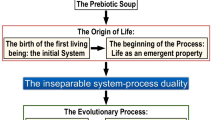Abstract
A list of selected phenomena characterizing living systems on the main levels of the manifestation of life is considered. As a result of directed interpretation of these phenomena, life (in becomming of earthly reality) appears as an informational physico-mathematical process that solves the problem of optimal relations of its variability and heredity in a changing environment. Practical solutions found by living systems in the course of evolution can be used and are used in applied mathematics as approaches of working with information. Genetic and quantum algorithms, neural networks, annealing are important milestones of this use. On this way, mathematics discovers an unexpected efficiency in working with big data arrays, which represent the main content of modern biology.
DOI 10.1134/S1061920822040082
Similar content being viewed by others
References
E. P. Wigner, “The Unreasonable Effectiveness of Mathematics in the Natural Sciences”, Comm. Pure Appl. Math., 131 (1960), 1–14.
V. I. Arnold, “On Teaching Mathematics”, Russ. Math. Surveys, 53:1 (1998), 229–236.
P. C. W. Davies, “Does Quantum Mechanics Play a Non-trivial Role in Life?”, BioSystems, 78 (2004), 69–79.
V. Fock, “Konfigurationsraum und zweite Quantelung”, Z. Physik, 75 (1932), 622–647.
V. P. Maslov, “On a General Theorem of Set Theory Leading to the Gibbs, Bose–Einstein, and Pareto Distributions as well as to the Zipf–Mandelbrot Law for the Stock Market”, Math. Notes, 78:6 (2005), 807–813.
J. von Neumann, Theory of Self-Reproducing Automata, University of Illinois Press, Urbana and London, 1966.
J. Holland, Adaptation in Natural and Artificial Systems, MIT Press, Cambridge, MA, 1992.
W. S. McCulloch and W. Pitts, “A Logical Calculus of the Ideas Immanent in Nervous Activity”, Bull. Math. Biophys., 5 (1943), 115–133.
O. Caramello, “The Unification of Mathematics via Topos Theory”, r**v:1006.3930 [math.CT] 2010.
V. Voevodsky, “An Experimental Library of Formalized Mathematics Based on the Univalent Foundations”, Math. Structures Comput. Sci., 25:5 (2015), 1278–1294.
E. T. Jaynes, Probability Theory: The Logic of Science, Cambridge University Press, 2003.
M. Gromov, Interview, Rigas Laiks 1, 2014.
D. W. Thompson, On Growth and Form, Cambridge University Press, Cambridge, 1992.
D. J. Taylor, N. P. O. Green, G. W. Staut, and R. Soper, Biological Science 1 & 2, Cambridge University Press, Cambridge, 2004.
L. von Bertalanffy, “The Theory of Open Systems in Physics and Biology”, Science, 111:2872 (1950), 23–29.
R. P. Feynman, QED: The Strange Theory of Light and Matter, Penguin Books, 1990.
R. Rosen, Life Itself: A Comprehensive Inquiry into the Nature, Origin, and Fabrication of Life, Columbia University Press, New York, 1991.
L. Brillouin, Science and Information Theory, Dover Publications, 2013.
S. A. Kauffman, “The Adjacent Possible”, Life: The Leading Edge of Evolutionary Biology, Genetics, Anthropology, and Environmental Science, Harper Perennial, (2016), 358–360.
G. Nicolis and I. Prigogine, Self-Organization in Nonequilibrium Systems, Wiley-Interscience, NewYork, 1977.
I. Prigogine and I. Stengers, Order Out of Chaos: Man’s New Dialogue with Nature, Heinemann, London, 1984.
S. J. Gould, Ontogeny and Phylogeny (The Belknap Press of Harvard University Press), Cambridge, 1977.
J. Lovelock, Novacene: The Coming Age of Hyperintelligence, The MIT Press, 2019.
P. P. Amaral, M.E. Dinger, T. R. Mercer, and J. S. Mattick, The Eukaryotic Genome as an RNA Machine, vol. 319, Science, 2008.
C. Shannon, “A Mathematical Theory of Communication”, The Bell System Technical Journal, 27:3 (1948), 379–423, 623–656.
N. Chomsky, Topics in the Theory of Generative Grammar, 1972.
D. Cram, “Preorganization – From Solvents to Spherands”, Angewandte Chemie-international Edition, 25:12 (1986), 1039–1057.
V. Vanchurin, Yu. I. Wolf, E. V. Koonin, and M. I. Katsnelson, Thermodynamics of Evolution and the Origin of Life, PNAS 119(6) e2120042119, 2022.
J. Huxley, Evolution: The Modern Synthesis, Harper and Brothers, 1943.
G. Mendel, “Versuche Uber Plflanzenhybriden”, Verhandlungen des naturforschenden Vereines in Brunn, 4 (1866), 3–47.
J. A. Wheeler, “Information, Physics, Quantum: The Search for Links”, in Proceedings III International Symposium on Foundations of Quantum Mechanics, (1989), 354–358.
M. A. Nielsen and I. L. Chuang, Quantum Computation and Quantum Information, Cambridge University Press, 2011.
S. L. Nuismer, B. Week, and L. J. Harmon, “Uncovering Cryptic Coevolution”, The American Naturalist, 199:6 (2022), 869–880.
W. J. Ripple, C. Wolf, T. M. Newsome, M. Galetti, M. Alamgir, E. Crist, M.I. Mahmoud, W.F. Laurance, 15,364 scientist signatories from 184 countries, “World Scientists’ Warning to Humanity: A Second Notice”, BioScience, 67:12 (2017), 1026–1028.
Yu. N. Zhuravlev, M. A. Guzev, and A. I. Gudimenko, “Protein Synthesis as an Object of Physical and Mathematical Research and Modeling”, Siberian Electronic Mathematical Reports, 16 (2019), 340–368.
V. P. Maslov, “Violation of the Determinacy Principle of Nonstationary Equations of Two- and Three-dimensional Gas Dynamics for Sufficiently Large Reynolds Numbers”, Theor. Math. Phys., 69 (1986), 1202–1212.
Author information
Authors and Affiliations
Corresponding author
Rights and permissions
About this article
Cite this article
Guzev, M.A., Zhuravlev, Y.N. To the Justification of the Effectiveness of Future Mathematics in the New Biology. Russ. J. Math. Phys. 29, 500–507 (2022). https://doi.org/10.1134/S1061920822040082
Received:
Revised:
Accepted:
Published:
Issue Date:
DOI: https://doi.org/10.1134/S1061920822040082




